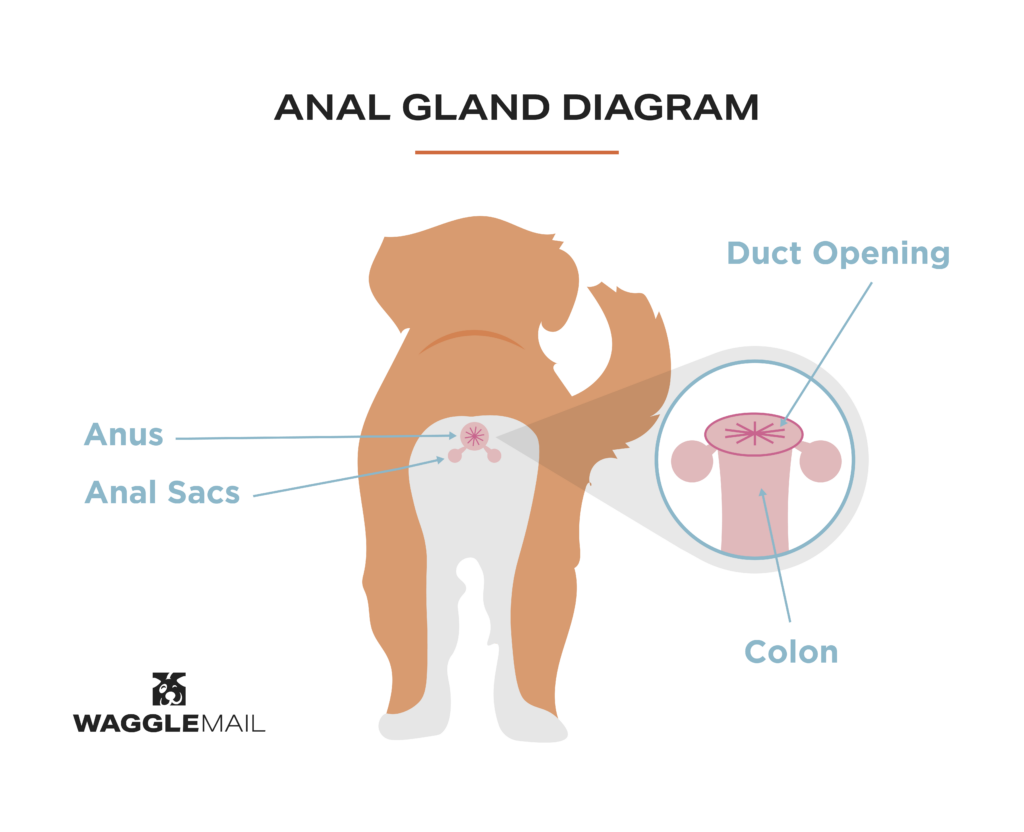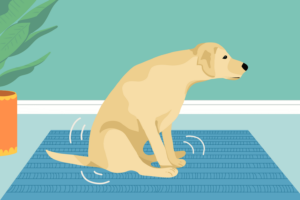Dog anal glands: a pain in the butt, literally.
Dog anal glands are scent glands located on either side of a dog’s anus. Technically speaking, the accurate term is anal sac, and glands are within that sac, but that’s how most people refer to it. These glands are not essential for your pet’s overall health but play a role in scent-marking and communication by releasing a distinct, foul-smelling fluid. However, issues with anal glands, such as abscess formation, can cause pain and discomfort for our canine companions.
In this blog, we will explore the anatomy of dog anal glands, dog anal gland issues, the impact of dog allergies on anal gland health, symptoms of anal gland problems, and effective solutions to manage and prevent.
Dogs anal glands and their anatomy
Both male and female dogs have anal glands, with two glands positioned on either side of the anus underneath the skin and hidden from the naked eye. Each gland is connected to the anal canal through a small duct. During defecation, the pressure from passing stool helps to empty the sacs, releasing characteristic brown secretions that normally have a consistency between water and oil.
This liquid is meant to come out a bit at a time in dogs, but with animals like skunks the anal glands are used as a potent defense mechanism, one which we all know to avoid.
The inner workings of healthy glands are hidden, and you will not notice them excreting or refilling. Usually, the only hint of their existence is your pet sniffing another dog’s butt to exchange scents, or when things start to go ary.

Dog anal gland issues
Anal glands in dogs can occasionally cause larger, painful problems that need to be further dealt with. Smaller breeds of dogs tend to be more predisposed to anal sac disease, but all dogs can go through anal gland turmoil. Some problems include:
Impaction
Sometimes the small ducts or openings become blocked or too inflamed for anal gland secretions to pass normally. The gland will start to fill and stretch as it gets backed up, ultimately causing discomfort. Impaction becomes a vicious cycle as the longer secretions sit within the duct, the more firm they become, making it even more difficult to pass on its own or with manual expressions (more on expressing anal glands later).
Infection
When anal glands are not draining properly or become impacted, they are also at a higher risk of developing an infection. Bacterial growth in the retained fluid can lead to redness, swelling, and even an abscess formation.
Abscess
An anal gland abscess in dogs is a painful infection that occurs when the glands become impacted and infected. The accumulated purulent material (slang being puss) causes the gland to swell, and in severe cases, it may even lead to a ruptured anal gland (ie. 1 to 2 uninvited holes where the anal gland(s) used to live, with blood oozing out – not a pretty picture!)
Cancer
Tumors can also rarely develop and spread within the anal sac, gland, duct or adjacent tissue.
Dog allergies and their impact on anal glands
Dog allergies, particularly food allergies and environmental allergies (or a combination of both) can contribute to anal gland issues in dogs. The inflammation caused by allergies can lead to narrowing or closing of the gland ducts, preventing proper emptying. If your pet has any food sensitivities or allergies, discuss a treatment with your veterinarian. This could include a hypoallergenic diet, medication and supplements to help reduce inflammation within the body. This will also help aid the normal function of the anal glands.
How to tell if dogs anal glands are full
Recognizing the signs of dog anal gland issues is crucial to ensure early intervention. Look out for the following symptoms:
- Scooting: Dogs may drag their rear end on the ground to relieve discomfort and release the fluid.
- Tail and anal area biting: Some animals may traumatize their tail and backend due to discomfort.
- Discoloration or loss of fur under the tail: Dogs may excessively lick the fur under their tails in response to anal gland irritation
- Reluctance to sit or defecate: With a painful butt your dog may not want to sit, or they become constipated
- Signs of pain: Crying out for no apparent reason, whimpering, circling or posturing strangely, or withdrawal are all potential signs of pain
- Swelling and redness: The anal area may appear swollen and red overall, or 1 to 2 raised red bumps might start to appear.
Expressing anal glands
Dog anal gland expression is not for the faint of heart when it comes to dealing with unpleasant odours. The anal sacs can be emptied in one of two ways:
- Externally: Hold up a rag or tissue to the anus and squeeze both sides of the anal area. If the secretion is too thick or pasty, this method may be inadequate to empty the sacs fully.
- Internally (usually performed by animal professionals): Insert a lubricated, gloved finger in the anus and squeeze the sac between thumb and forefinger into a tissue held externally. The full anal gland feels like a grape in the correct location. The emptying procedure is repeated on the opposite side. Leave this procedure to your veterinary professionals if your dog is painful, swollen, or if it does not express easily – you do not want to rupture the gland yourself internally.
Dog ruptured anal-gland abscess home treatment
If your pet shows signs of an anal gland abscess, it is best to seek veterinary care promptly. While not necessarily a medical emergency, the abscess is painful, infected, and can lead to further complications if left untreated. Until you can get into your vet the best things you can do at home in the interim are:
- Keep your dog from licking their butt with an e-collar
- Use a warm clean rag or small towel to compress their hind end for 5-10 minutes, 2-3 times a day
- Clean the area with hygienic pet wipes
- Contain them in an easy-to-clean area
- Take them for frequent bathroom breaks to monitor their bowel movements
- Ensure they are drinking plenty of water to stay hydrated
- Get them started on a therapeutic anal gland supplement
Treatment at your family veterinary clinic may include:
- Cleaning and draining: The veterinarian might recommend sedating your dog to clean out the abscess and remove the accumulated discharge.
- Medications: Anti-inflammatory pain medications and antibiotics may be prescribed to reduce swelling and treat infection.
- Recheck expressions: Follow-up anal gland expression with your veterinary team are crucial to ensure proper healing and monitor progress.
- Anal sacculectomy surgery: In severe and chronic cases, the surgical removal of the anal glands may be considered as a last resort.
Preventing anal gland issues
Preventing anal gland issues involves understanding and diagnosing the underlying causes and then addressing them effectively. Here are some things to consider doing to lower the risk for your dogs anal glands:
Identify allergies: work with your veterinarian to help identify and manage your dog’s potential allergies, which can improve anal gland health by reducing inflammation.
Feed a proper diet: dogs with food allergies may require a hypoallergenic diet. Others may simply need a high-quality food with adequate fiber levels to help keep defecation regular (2-3 formed bowel movements daily). Bowel movements also need to have just enough bulk to help apply pressure on the anal glands to help them empty.
Supplement with fiber: if you suspect your dog’s diet does not have enough fibre content, like a raw formulation, supplementation is an easy way to bulk up stool like with Probenz-VM Probiotic Enzymes & Fiber formula.
Regular anal gland expressions: if your dog’s anal glands are chronically impacted or have abscessed, regularly scheduled visits to your veterinarian are often necessary, or at minimum as soon as you see your dog scooting. Some groomers may also express anal glands, but usually do external expressions which are not deep enough for some dogs. Veterinarians can also pick up on other problems that may be contributing and provide recommendations as such.
Manage weight: ensuring that your dog is at a healthy weight, or ideal body condition score will minimize the risk of developing anal gland problems, among other concerns. Obesity causes the glands to be surrounded by fatty tissue which make it more difficult for them to empty.
Dog anal glands can be a royal pain in the butt, but at least now you have some tips and tricks to help keep your dog’s anal glands healthy and happily contributing to their overall well-being.
If you found these anal glands tips to prevent dog anal gland issues helpful, subscribe to Waggle (e)Mail for more fun, easy, and effective ways to promote a healthy body, healthy mind, and healthy pet-parent bond.


